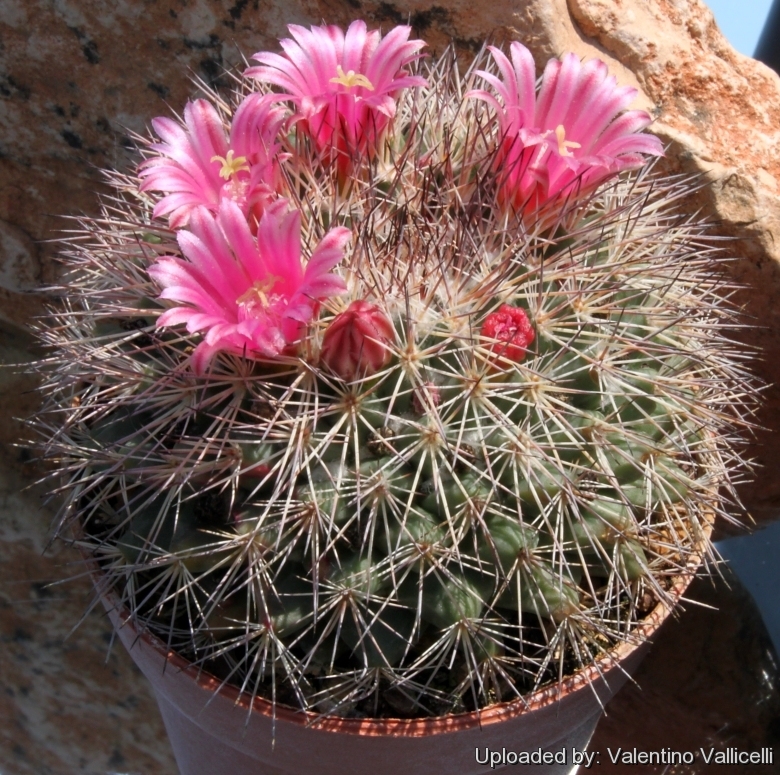
Mammillaria grusonii Photo by: Valentino Vallicelli
Origin and Habitat: Mammillaria grusoniiSN|15974]]SN|15974]] is endemic to Mexico, where it can be found in the states of Coahuila (Sierra Bola, Cerro Bola, Viesca, Puerto de Ventanillas, San Pedro de las Colonias, Cuatrocienegas, Cerro Zavaleta, El Carmen, San Rafael, Pinaje de Leone, Pomona/Paile, La Pena, Tacubaya, Torreon - Cuencame, San Antonio, El Amparo, La Cuchilla), and Durango (Penon Blanco, Nazas - Rodeo, Belem, La Concha, Cuencame, San Bartolo, Cerro Visnaga, Lerdo, Santiago Papasquiaro). It may possibly occur in Sinaloa.
Altitude range: at about 800 - 1.850 m of altitude
Habitat and ecology: This cactus appears to occur in a variety of habitats, from xerophytic shrubland to grassland and woodland. It often grows on the top and slope of hills, or in flat areas on rocky limestone and on volcanic soils in the Sierra Madre. Mammillaria grusoniiSN|15974]]SN|15974]] is a widespread species, and although it is not abundant or common, more as scattered individuals, there are no threats to cause any concern.
Synonyms:
See all synonyms of Mammillaria grusonii
back
Accepted name in llifle Database:Mammillaria grusonii C.RungeGartenflora xxxviii. (1889) 105. fig. 20. ( "grusoni" )Synonymy: 8
back
Common Names include:
UKRAINIAN (Українська): Мамілярія грузоні, Мамілярія Грузона
Description: Mammillaria grusoniiSN|15979]]SN|15974]] is undoubtedly one of the largest species in the genus and usually solitary (it has a tendency to remain the same in the culture). It reveals its true beauty only as it becomes 6 -10 years old, and reaches 30 cm or more in diameter. This species shows a considerable variation in the spination, from quite short spines to very long, the latter named as Mammillaria tesopacensis var. papasquiarensisSN|15974]]SN|15979]] at one time.
Stems: globose to thick cylindrical, light blue-green, up to 30 cm and 25 cm in diameter.
Tubercles: Basally four-angled, carinate, without latex, the axil is woolly at first, later naked.
Radial spines: 12-14, straight, needle-like, upper ones shorter, 6-8 mm long, at first reddish, tipped brown, later grey or snowy- white.
Central spines: Usually 2 (or rarely 3), straight, stronger than the radial, one ascending, one descending, 4-6 mm long.
Flowers: Bell shaped, funnel-form, diurnal, light yellow-cream or pinkish with darker (brown or purple) midstripe with a yellowish throat, up to 25 mm long and in diameter.
Blooming season: Spring, and flowers remain open for about three or four days.
Fruits: Scarlet, club shaped.
Seeds: Brown.
Subspecies, varieties, forms and cultivars of plants belonging to the Mammillaria grusonii group
- Mammillaria durangicola Repp.: This form has 10-16 radials, 4-15 mm long, 1 - 3 central, 10-17mm long, black, and flowers as in Mammillaria pachycylindrica, with a brownish midstrip.
 Mammillaria grusonii C.Runge: It is one of the largest species in the genus and usually solitary, it reaches 30 cm or more in diameter.
Mammillaria grusonii C.Runge: It is one of the largest species in the genus and usually solitary, it reaches 30 cm or more in diameter.- Mammillaria mexicensis R.T.Craig: has dark pink flowers.
 Mammillaria pachycylindrica Backeb.: (Reppennhagen considered it a separate form) with more spines, 20–23 grayish-white radials and about 6 centrals, at first dark, blackish-brown, becoming gray, tepals lobes with a wide brownish-pink midstrip.
Mammillaria pachycylindrica Backeb.: (Reppennhagen considered it a separate form) with more spines, 20–23 grayish-white radials and about 6 centrals, at first dark, blackish-brown, becoming gray, tepals lobes with a wide brownish-pink midstrip. Mammillaria papasquiarensis (Bravo) Repp.: is a long spined form, with 8-10 radial spines, 5-40 mm long, and 1 to 3 central spines, 40 - 100 mm long. The flowers are white with a pinkish midstrip.
Mammillaria papasquiarensis (Bravo) Repp.: is a long spined form, with 8-10 radial spines, 5-40 mm long, and 1 to 3 central spines, 40 - 100 mm long. The flowers are white with a pinkish midstrip.- Mammillaria tinuvieliae Laferr.
 Mammillaria zeyeriana F.Haage ex K.Schum.: The spines are of intermediate measurement, of which the radials are 10 to 15, 8-15 mm long, and the centrals usually 4 (but sometime up to 6), 12 - 25 mm long. The flowers are similar to those of Mammillaria papasquiarensis.
Mammillaria zeyeriana F.Haage ex K.Schum.: The spines are of intermediate measurement, of which the radials are 10 to 15, 8-15 mm long, and the centrals usually 4 (but sometime up to 6), 12 - 25 mm long. The flowers are similar to those of Mammillaria papasquiarensis.
Bibliography: Major references and further lectures
1) John Borg “Cacti: a gardener's handbook for their identification and cultivation” Blandford P., 1970
2) Nathaniel L. Britton, J. N. Rose “Cactaceae: Descriptions and Illustrations of Plants of the Cactus” Volume IV. The Carnegie Institution of Washington Washington, 24/Dec/1923
3) Edward Anderson “The Cactus family” Timber Press, Incorporated, 2001
4) James Cullen, Sabina G. Knees, H. Suzanne Cubey "The European Garden Flora Flowering Plants: A Manual for the Identification of Plants Cultivated in Europe, Both Out-of-Doors and Under Glass" Cambridge University Press, 11/Aug/2011
5) David R Hunt; Nigel P Taylor; Graham Charles; International Cactaceae Systematics Group. "The New Cactus Lexicon" dh books, 2006
6) John Pilbeam “Mammillaria: the cactus file handbook” Cirio Publishing Services Ltd Dec/30,/1999
7) Fitz Maurice, B, Fitz Maurice, W.A., Hernández, H.M., Sotomayor, M. & Smith, M. 2013. Mammillaria grusonii. The IUCN Red List of Threatened Species. Version 2014.3. <www.iucnredlist.org>. Downloaded on 23 April 2015.
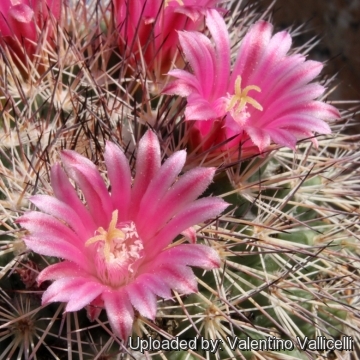 Mammillaria grusonii Photo by: Valentino Vallicelli
Mammillaria grusonii Photo by: Valentino Vallicelli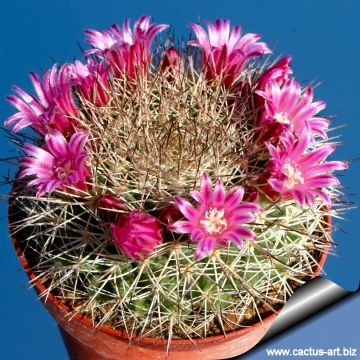 Mammillaria grusonii Photo by: Cactus Art
Mammillaria grusonii Photo by: Cactus Art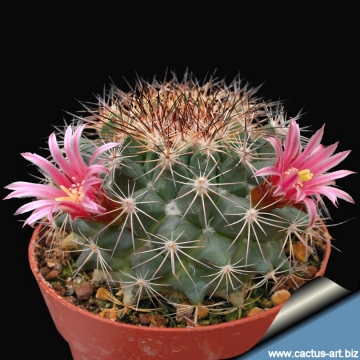 Mammillaria grusonii Photo by: Cactus Art
Mammillaria grusonii Photo by: Cactus Art Mammillaria grusonii Photo by: Cactus Art
Mammillaria grusonii Photo by: Cactus Art Mammillaria grusonii Photo by: Cactus Art
Mammillaria grusonii Photo by: Cactus Art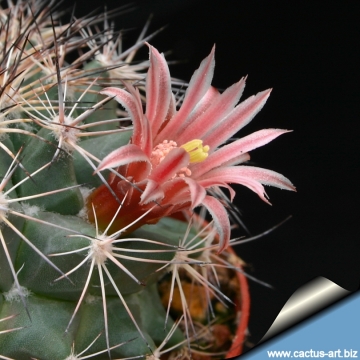 Mammillaria grusonii Photo by: Cactus Art
Mammillaria grusonii Photo by: Cactus Art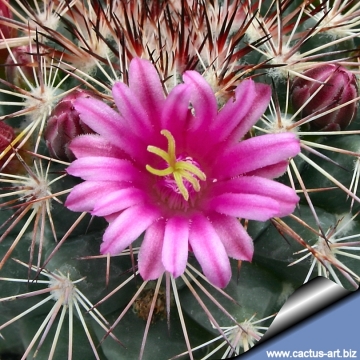 Mammillaria grusonii Photo by: Cactus Art
Mammillaria grusonii Photo by: Cactus ArtSend a photo of this plant.The gallery now contains thousands of pictures, however it is possible to do even more. We are, of course, seeking photos of species not yet shown in the gallery but not only that, we are also looking for better pictures than those already present.
Read More... Cultivation and Propagation: This plant blooms easily and needs lots of light. Use a pot with good drainage and a very porous mineral-based potting mix. Potted plants are quite wet-sensitive, especially in light of its small root system. Water sparingly during the growing season, let soil dry in between to prevent root rot, keep very dry in winter. Feed with a high potassium fertilizer in summer.
Usually it is recommended to over-winter this plant in a bright and warm greenhouse with at least 8-10° C , but it has proven to be quite frost resistant (if kept dry it is hardy as low as -7° C). A resting period in winter and strong light are necessary so that it can flower properly. Plants will offset readily, and dense clumps can be produced in a very few years.
Propagation: Through seeds and cuttings.

















